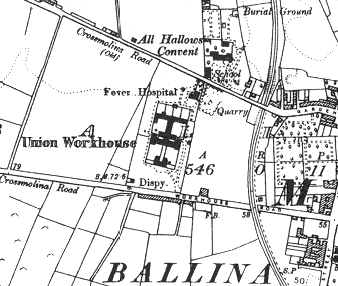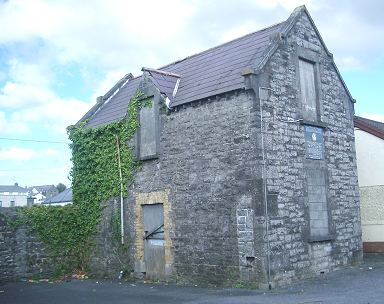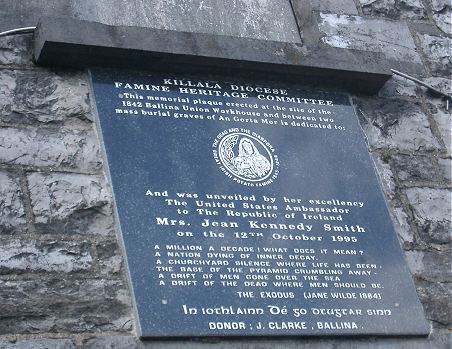Ballina, Co. Mayo
Ballina Poor Law Union was formed 13th July 1840 and occupied an area of 792 square miles. Its operation was overseen by an elected Board of Guardians, 33 in number, representing its 17 electoral divisions as listed below (figures in brackets indicate numbers of Guardians if more than one):
Co. Mayo:
Attymas, Backs (2), Ballina (4), Ballycastle, Ballysokeery (2), Belmullet (3), Binghamstown (3), Crossmolina (3), Kilfian (2), Kilgarven, Killala (2), Lackan (2).
Co. Sligo:
Ardnaree (2), Castleconnor, Dromore West, Easky (2), Kilglass.
The Board also included 11 ex officio Guardians, making a total of 44. The Guardians met each week on Monday at noon.
The population falling within the Union at the 1831 census had been 115,030 with divisions ranging in size from Attymass (population 3,276) to Crossmolina (11,479).
The new workhouse, built in 1840-42, was designed by George Wilkinson. It occupied a 9-acre site between the Crossmolina Road and the Old Crossmolina Road at the west of Ballina. In both area and population, Ballina was one of the largest Unions in Ireland. Its workhouse was intended to accommodate up to 1,200 inmates making it one of the largest in the country. Construction of the workhouse cost £9,400 plus £1,980 for fixtures and fittings etc. Its location and layout can be seen on the early 1900s OS map below:

Ballina workhouse site.
The buildings followed Wilkinson's typical layout. An entrance and administrative block at the south contained a porter's room and waiting room at the centre with the Guardians' board room on the first floor above. The main accommodation block housed the Master's quarters at the centre, and male and female wings to each side. At the rear, a range of single-storey utility rooms such as bakehouse and washhouse connected through to the infirmary and idiots' wards via a central spine containing the chapel and dining-hall.
It was declared fit for the admission of paupers on 15th November 1842 but did not admit its first inmates until almost a year later later on 3rd November 1843. Ballina suffered from ongoing financial difficulties because of local resistance to the paying of the poor rate needed to operate the workhouse. By 1847, the Union's debts amounted to some £2,000.
In common with other Unions in Ireland, Ballina suffered greatly during the famine years 1845-50, with the Union's financial problems also contributing to its distress. The overcrowding and conditions in the workhouse at the end of 1847 were described in letters to the Poor Law Commissioners which appeared in the British Parliamentary Papers of 1848:
December 5,1847.
With reference to my letter of yesterday's date, in which I stated that 300 paupers were to be removed yesterday from the workhouse to the store, which a Committee of the Guardians had taken in the morning, I beg to acquaint you that notwithstanding the greatest exertions on the part of the officers of the workhouse, it was found impracticable to move them earlier than this day; consequently 1698 person had to be provided for last night in the workhouse.
I was at the workhouse early today, and had every possible precaution taken against infection.
The applicants for admission are in the most miserable and filthy state; there is neither bedding nor clothing for 600.
I am now going to see the Chairman of the Board, with the view of summoning a special meeting of the Guardians.
I must say, I think that the Guardians ought to have been earlier prepared. On the 8th November, I requested them to make arrangements for giving outdoor relief to persons legally entitled to it, but this step was deferred until it was too late to be of any use. Unless the Board meet more frequently, and give more time to business, it is impossible that they can carry on the business of this large Union properly.
MR. DEVLIN to LIEUT. HAMILTON:
December 10, 1847.
I am just now returned from visiting the patients in the infirmary. They are suffering much, in consequence of the numbers that are crowded into it.
I have no hesitation in saying that, unless additional accommodation be procured for the sick, many lives will be sacrificed; indeed, in order to keep the house in a healthy state, several hundreds of the present inmates ought to be removed; and may I beg that you will call the attention of the Guardians to this subject.
A small fever hospital was erected the north of the site and a dispensary was located near to the road at the south-west.

Ballina workhouse dispensary from the south-west, 2003.
© Peter Higginbotham.
On 6th March, 1850, the Ballina Chroncle repoted that:
Women's Petticoats....................524
Women's Gowns........................299
Women's Chemises....................827
Women's Caps...........................551
Girls' Frocks...............................398
Girls' Chemises...........................803
Girls' Petticoats...........................265
Men's Trousers............................ 27
Men's Shirts................................340
Boys' Suits..................................107
Boys' Shirts.................................256
Besides these many more articles of clothing are in course of being made, and a large quantity of material is in course of delivery which has been a long time ordered. Two hundred pairs of blankets, two hundred rugs, and one hundred and fifty bed-ticks have also been purchased since the first of January. One hundred stones of wool are contracted for, and in a day or two four or five hundred wheels will be at work spinning this and flax. Two hundred wheels and six looms are ready to commence work; so that in a short time it is expected, the greater portion of clothing required can be manufactured in the house from the raw material.
In 1852, parts of the Ballina Union were divided up to create several new unions: Belmullet, Dromore West, and Killala.
At the 1901 census, the population of the reduced Ballina Union was 24,653.
Most of the original workhouse buildings were demolished in the early 1930s to make way for the Ballina District Hospital, now a County Care Centre. Only the dispensary now remains — it bears a commemorative plaque for the workhouse and two nearby mass burial graves.

Ballina memorial plaque, 2003.
© Peter Higginbotham.
Inmates
Records
Note: many repositories impose a closure period of up to 100 years for records identifying individuals. Before travelling a long distance, always check that the records you want to consult will be available.
- National Archives of Ireland, Bishop Street, Dublin 8. Holds Board of Guardians' minute books and other papers.
- Local History Department, Castlebar Central Library, Castlebar, Co Mayo.
Bibliography
- The Workhouses of Ireland by John O'Connor (Anvil Books, 1995)
- The Famine in Mayo 1845-1850 compiled and edited by Ivor Hamrock. Mayo County Council, 1998.
Links
- None.
Unless otherwise indicated, this page () is copyright Peter Higginbotham. Contents may not be reproduced without permission.


